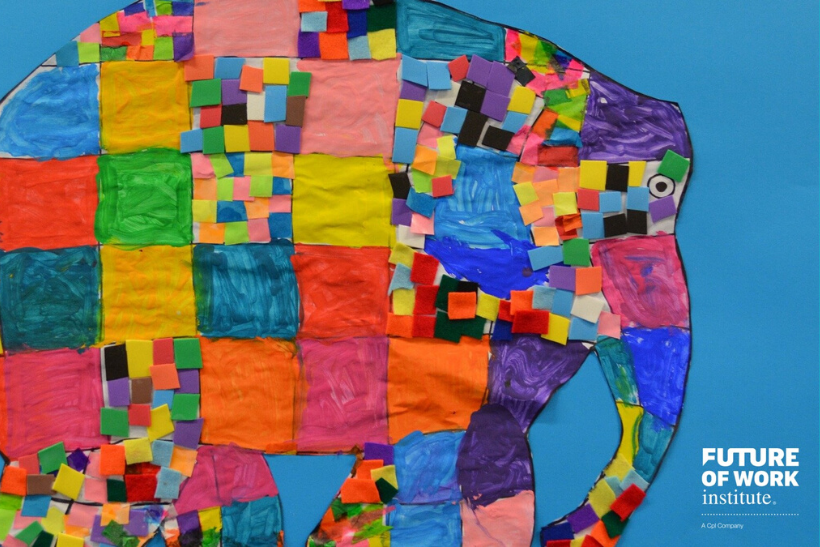I recently had the pleasure of attending an all Ireland Lego League event. An event charged full of youthful energy, collaboration and competition in equal measure, and above all spectacular levels of innovation (the practical realisation of creative ideas) and creative thinking.
As Head of The Future of Work Institute with Cpl, I am acutely aware of the need for organisations to fully harness creative leadership and deep conscious creativity to help them sustain innovation into the future. There is a general and often subjectively held view that diversity is one critical pillar & driver in developing the consciously innovative firm.
To Have and To Harness - Innovation through Diversity
Whilst the quest for truly diverse and inclusive organisations is a noble and rightful one, it doesn't necessarily equate to higher levels of innovation.
Much is being made, for example, of the '5 generations workforce' but it hasn't led to a spike in creativity in these firms. My big fear is that in our drive to create an equitable workplace across the various societal lenses of diversity like gender, colour, creed, orientation, generational and neurological (finally moving us towards a 'full spectrum societal workplace') the harness side of the equation is being left behind. I think this will lead to major challenges in the workplace of the future.
'Diversity 'have' is a noble and just goal that needs to happen, but we are forgetting about the 'harness''
As leaders can we truly say that today we are harnessing diversity to drive innovation? Harnessing diversity to get to a place of higher creativity that improves total business performance? I am not convinced.
Whilst diversity in most firms is increasing engagement levels are still pitifully low (15-20%). The advent of new technologies that have promised a 'more human workplace' (I always wonder that this actually means, an obvious-ism with no definition) haven't yet fully realised a socially inclusive workplace.
I recently spoke to a senior executive about how project teams are formed for critical innovation projects and the word 'diversity' didn't come into the conversation, but 'key technical capabilities' did.
'We are running the risk of turning the diversity quest into a 'tick box' exercise'
A Fundamental Contradiction
In my view there is a fundamental contradiction at play for most organisations when it comes to harnessing true diversity. As leaders, we drive for cultural fit but we also desire diversity.
I think we have a problem here. On one hand, we are saying 'we want different' but on the other, we are saying 'we want the same'- so what is it?
What do we really want? Is it possible that this contradiction is at the core of an organisations ability to properly harness diversity and unleash its potential? A fundamental contradiction is at play here.
Going Deeper to Get To Simplicity
Being able to harness something also requires us to go beyond the surface level, beyond the obvious. I am finding the most compelling research on Diversity focuses on 'deep-level diversity'. It seems that at this level we can better draw linkages between it and impact.
Deep level diversity refers to 'cognitive diversity.' How humans feel, think and act. For example, many studies are finding that psychology outweighs demography when it comes to diversity's impact on performance.
One of my favourite papers on this area is by Torchia, Calabro & Morner 2015 which highlighted that boards of directors who are more heterogeneous in terms of their personalities, thinking styles and values, tended to harness diversity more during discussions, resulting in more creative and innovative decision-making.
Too Much of a Good Thing Can Be a Bad Thing
In general a more diverse team (in relation to personality, values and ability) perspective will generate a wider range of diverse ideas.
However, when it comes to prioritising these ideas and implementing them diversity can actually have a negative effect due to social conflict and decision-making deficits (Chamorro-Premuzic 2017). As leaders, we need to be mindful of the where and when we need to drive a heterogeneous approach and when to use a more homogeneous approach to fully harness diversity and optimal execution.
Where to?
I'd like to ask leaders a simple question - how many diversity harness initiatives do you have versus diversity have initiatives?
I guarantee that the ratio between Have and Harness is about 20:1. Now many people would argue that when it comes to diversity it's not about harnessing it, it's about having it. But I think this is unrealistic and myopic.
If we are trying to create a fully engaged workforce of motivated human beings then we must be able to fully harness the workplace diversity we have fought (and continue to fight) for.
For me when we speak about inclusion and inclusive practices what we really mean is properly harnessing surface-level and deep-level diversity for business and social impact.
We too often separate Diversity from Inclusion (now belonging!) in the literature but this seems to weaken the overall concepts.
I look forward to the day when we are celebrating a world where the harnessing of organisational diversity has contributed to solving some of the world's wicked problems.
If you would like to find more about incorporating a strong diversity and inclusion policy within your organisation pleaseget in touch, we'd be delighted to advise.
